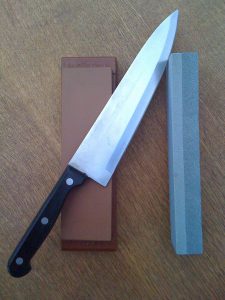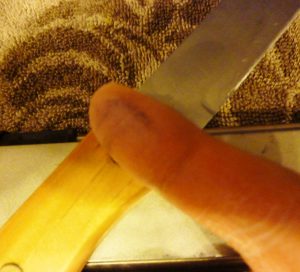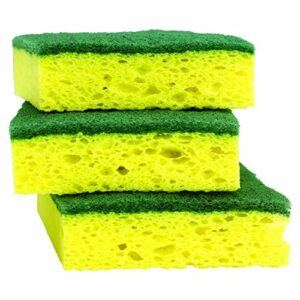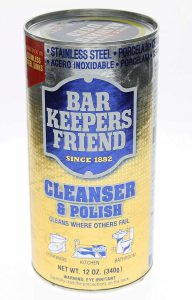
Why Should You Bother Cleaning Your Stones?
2 years ago, you found a wicked set of ceramic stones and have been using them religiously ever since. A year later, you wanted to see what all the hype was around diamond stones, so you went and purchased 3 of them. Fast forward to present day where your stone collection has grown in size, and you now have a new problem: maintenance. So you scour the internet, and end up here on myelectricknifesharpener. Today’s post aims to discuss how to clean a sharpening stone; we will be looking at 4 different ways to do this. But, before we get to the specifics, why should you bother cleaning your stones, and what are the implications if you don’t?

To understand this, let’s look at what happens every time you sharpen a knife. Knife sharpening is the very gradual removal of steel done to achieve as sharp an edge as possible. So if steel is being removed from your edge, have you thought about where it ends up? Yes, it ends up on the surface of your stone. That’s why almost every stone will tend to discolor over time. The transfer of steel from knife to stone is called loading. Excessive loading greatly reduces the abrasive quality of your stone. In other words, you can expect your results to be less than average (relatively speaking when compared to a stone with minimal loading). Without ranting on further, clean your stones because it makes a difference! A huge difference!

Important: Not All Stones Are The Same!
Here’s something most people don’t tell you when talking about stone maintenance: not all stones are the same, and as a result the way you maintain a diamond stone for example, may not necessarily be the same way you maintain and clean an oil stone. Don’t take this lightly! Each stone may behave differently than the other, and you must understand this prior to cleaning. Most stones are porous and will tend to soak up fluids that they’re contacted with. For the purpose of this post, I will be discussing how to clean diamond/ceramic stones only, and that’s because I am familiar with those types. For other stone types, you should do some research and try to find what has worked for others. Alright, let’s talk about what you need.
You Need To Get These First!
When talking about how to clean a sharpening stone, special attention should be given to 2 things: applicator and the cleaning substance. Cleaning substance could be anything from water, oil, alcohol etc. The applicator is what you use to apply and work the water, or alcohol. Some applicators are better than others. I have 2 favorites that I’ve always had great success with: toothbrush and a scotch brite pad. Everyone has an old toothbrush lying around in their bathrooms. Instead of chucking it in the garbage, bring it down to the kitchen and let’s put it to good use!

Another awesome applicator is the scotch brite pad. You can find this just about anywhere. Go to your closest Walmart and get yourself a pack. I like to use both applicators, starting out by applying and lightly scrubbing with a toothbrush and then finishing off with the scotch brite pad. I’ve found this method to be the most effective. More on the process below!

It’s All In The Process
For the 4 methods, I strongly recommend you follow the process outlined below. I’ve found it works much better than any other way, and as a result my stones are much cleaner by the time i’m done. Also, the toothbrush/scotch brite scrub is not as aggressive as compared to using, say steel wool for example. If you have a routine/process that works for you, please leave a comment and share! For those who don’t, check out the steps below:
- Start out with a light toothbrush scrub by evenly applying the cleaning substance and scrubbing in small circular motions. Take your time and spend a couple minutes completing this step.
- Give your stone a quick rinse under lukewarm water.
- After rinsing, you can do a quick scrub down with your scotch brite pad. Make sure you cover all areas of the stone.
- Give the stone a final rinse and dry with a microfiber towel.
- At this point, you should leave the stone for a couple hours to allow for evaporation of any residual water.
- Go ahead, use your stone and get sharp!
#1 Soapy Water Mix Does The Trick!
A soapy hot water mix works really well for both diamond and ceramic stones. Most people soak their stones in a mixture of dawn and hot water, scrubbing along as required. I like to do things a little differently. Instead of letting my stone sit in a soapy water mix, I follow the exact process above. Repeat 1-6 with dawn as the cleaning substance; if you don’t have dawn, any other dish detergent should be fine. This method works well for stones that are not excessively loaded. If your stones are excessively loaded, you should still give this method a shot. If you still have lots of steel on your stone after the fact, go to #2 below.

#2 Bar Keepers Friend: A Product That Does Wonders
Have you heard of bar keepers friend? If not, you need to get your hands on some, as this stuff is seriously awesome. It’s incredibly versatile and can be used in so many different ways. I use the powdered version of bar keepers friend, and what I typically do is make a thick viscous paste by mixing with water. I then set this aside in a small bowl. Be generous and apply liberally! Once you have your paste ready to go, you basically follow steps 1 through 6 ensuring you rinse and dry as required. This method works particularly well for heavily loaded stones.

#3 Comet/Water Paste: Cheap, Easy & Effective
Comet is a powdered cleaning product that is mostly used in the kitchen and bathroom. You’ve probably used it to clean your sink or even your toilet bowl at some point. Comet is also the answer of how to clean a sharpening stone. Just like the bar keepers friend, make a thick paste and use a generous amount of Comet. Follow the outlined process, and your stones will be looking great again! If you’re unable to get your hands on some Comet, you can use the powdered form of Ajax. It works just as well.
#4 Breakfree Gun Cleaner
I like methods 1-3 more than this one, so I suggest you try out those first. Breakfree is great product, but it’s not as readily available as Comet, Ajax, or Bar Keepers Friend; It’s also not as cheap as the others. I like the Breakfree spray on, so this is what I would recommend if you’re getting some. Spray this on, instead of making a paste and follow the process outlined earlier.
That’s How To Clean A Sharpening Stone…In My Opinion At Least!
The 4 methods above have all worked for me and restored my stones to almost looking as good as new. Here are 2 important things you should remember: 1. Removing most or all of the loaded steel can be challenging and requires patience (which brings me to number 2). 2. You may need to use a combination of methods 1-4 depending on how dirty your stone is. For light loading, method 1 is acceptable. For excessive loading, either method 2, 3, or 4 should work fine.

I’d like to reiterate that the advice given in this post is only applicable for diamond & ceramic type stones. I do not know if the same process & products work well for other stone types. For other stone types, I recommend you do some research and find what works best…..drop me a comment and let me know when you do! I am interested to know! If you enjoyed reading this post and found it useful, a share would be appreciated! See you next week people!
Featured Image Source: Reprofiling TOPS Sparrow Hawk from saber grind to flat grind By Thirteen Of Clubs CC BY-SA 2.0
